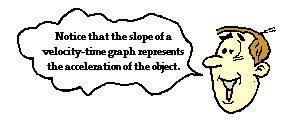The Importance of Slope
 The shapes of the velocity vs. time graphs for these two basic types of
motion - constant velocity motion and accelerated
motion (i.e., changing velocity) - reveal an
important principle. The principle is that the slope of the line on a velocity-time graph reveals useful
information about the acceleration of the object. If the acceleration is zero, then the slope is zero (i.e., a
horizontal line). If the acceleration is positive, then the slope is positive
(i.e., an upward sloping line). If the acceleration is negative, then the slope
is negative (i.e., a downward sloping line). This very principle can be
extended to any conceivable motion.
The shapes of the velocity vs. time graphs for these two basic types of
motion - constant velocity motion and accelerated
motion (i.e., changing velocity) - reveal an
important principle. The principle is that the slope of the line on a velocity-time graph reveals useful
information about the acceleration of the object. If the acceleration is zero, then the slope is zero (i.e., a
horizontal line). If the acceleration is positive, then the slope is positive
(i.e., an upward sloping line). If the acceleration is negative, then the slope
is negative (i.e., a downward sloping line). This very principle can be
extended to any conceivable motion.
The slope of a velocity-time graph reveals information about an object's acceleration. But how can one tell whether the object is moving in the positive direction (i.e., positive velocity) or in the negative direction (i.e., negative velocity)? And how can one tell if the object is speeding up or slowing down?